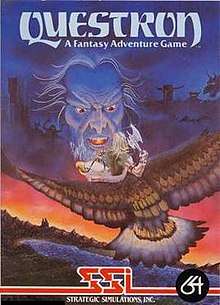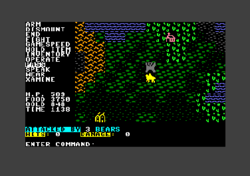Questron (video game)
Questron is a 1984 game from Strategic Simulations, the first fantasy title from a company known for computer wargames. It was written by Charles Dougherty and Gerald Wieczorek and released for the Apple II, Atari 8-bit family, and Commodore 64. A sequel, Questron II, was released in 1988.
| Questron | |
|---|---|
 Cover art | |
| Developer(s) | Strategic Simulations |
| Publisher(s) | Strategic Simulations |
| Designer(s) | Charles Dougherty Gerald Wieczorek |
| Platform(s) | Apple II, Atari 8-bit, Commodore 64, |
| Release | 1984 |
| Genre(s) | Role-playing video game |
| Mode(s) | Single-player |
After an out-of-court settlement, the structure and style of the game were both officially licensed from Richard Garriott, author of Akalabeth and Ultima.[1][2][3]
Gameplay

In the first Questron game, the player takes on the role of a young serf who tries to make a name for himself by traveling the realm in order to gain the power and experience necessary to defeat the wicked "Mantor", ruler of the "Land of Evil".
The view is mostly in top-down style for the world maps and town encounters, but switches to a first-person style in the dungeons of the Land of Evil. Some features were novel for a game of its type at the time of its release. First there are two "games within a game" that allow the character to permanently increase dexterity or intelligence attributes if completed successfully. Also, various casinos about the towns allow the player to gamble for gold pieces in games of blackjack, roulette, and double or nothing.
Various monsters and foes are immune or more vulnerable to different weapons. The player would occasionally have to switch weapons depending on which enemy they faced in order to defeat them. Magic spells can also be cast, but only in the dungeon levels.
Reception
Questron was SSI's first RPG, and became the fastest-selling new game in the company's history at almost 35,000 copies in North America, more than triple the sales of the typical SSI game. Others followed, such as Phantasie, Wizard's Crown, Gemstone Warrior, and the Advanced Dungeons & Dragons Gold Box games.[4]
Computer Gaming World in 1984 stated "if you are in need of a new and challenging role-playing game similar in play to the Ultima scenarios, then look no further". James A. McPherson praised the 3-D dungeons and "an ending fit for a king", and concluded "the differences from the Ultima type game do make Questron refreshing. I await the sequels".[5] The magazine's Scorpia in 1991 and 1993 also liked the game and praised the ending.[6][7] Ahoy! in 1985 praised the Commodore 64 version of Questron, describing it as "one of those game that you start playing and suddenly realize it's three hours past bedtime. SSI should label the box 'potentially hazardous to your sleep'".[2]
References
- From Questron in-game menu screen, Apple II and Commodore 64 versions.
- Peterson, Cheryl (October 1985). "Questron". Ahoy!. pp. 64–65. Retrieved 16 October 2013.
- Maher, Jimmy (2014-06-25). "Of Wizards and Bards". The Digital Antiquarian. Retrieved 11 July 2014.
- Maher, Jimmy (2016-03-18). "Opening the Gold Box, Part 3: From Tabletop to Desktop". The Digital Antiquarian. Retrieved 19 March 2016.
- McPherson, James A. (June 1984). "Questron". Computer Gaming World (review). p. 18.
- Scorpia (October 1991). "C*R*P*G*S / Computer Role-Playing Game Survey". Computer Gaming World. p. 16. Retrieved 18 November 2013.
- Scorpia (October 1993). "Scorpia's Magic Scroll Of Games". Computer Gaming World. pp. 34–50. Retrieved 25 March 2016.
External links
- Questron at Atari Mania
- Questron at Lemon 64
- Images of Commodore 64 version of Questron box, manual, and screen shots at C64Sets.com
- Review in Electronic Games